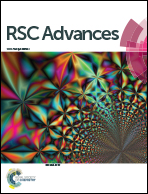Sophorolipid assisted tunable and rapid gelation of silk fibroin to form porous biomedical scaffolds†
Abstract
Three dimensional polymer hydrogels, based on both natural and synthetic polymers, are increasingly being used as scaffolds and drug delivery vehicles for biomedical applications. Fibrous protein, silk fibroin (SF), obtained from the Bombyx mori silkworm is a promising candidate in this area. However, SF has a long gelation time of about a few weeks that can only be reduced by non-physiological treatments (e.g. high temperature, ultrasonication and low pH) or by addition of a chemical and non-biodegradable polymer and/or surfactant. We report here accelerated gelation of SF under physiological conditions using a biosurfactant, sophorolipid (SL) as a gelling agent. SL and SF are completely miscible and form a very clear solution upon mixing. Hence it is interesting to see that this clear solution gels in a time span of just a few hours. The hydrogels so formed have pore architecture, porosities and mechanical stability ideally suited for tissue culture applications. Here we also demonstrate that mouse fibroblast cells not only adhere to but also extensively proliferate on these SF–SL scaffolds.


 Please wait while we load your content...
Please wait while we load your content...